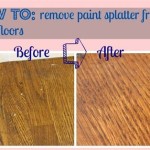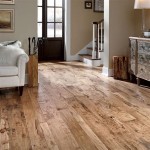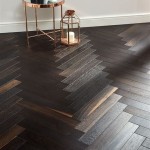How to Remove Carpet Adhesive From Hardwood Floors
Removing carpet adhesive from hardwood floors is a challenging but often necessary task. Many homeowners discover remnants of old carpet glue after tearing out carpeting, revealing adhesive residue that detracts from the natural beauty of their hardwood floors. The successful removal of this adhesive requires patience, the right tools, and a methodical approach. The adhesive's type, age, and the hardwood floor's finish all play a role in determining the optimal removal method. It’s crucial to proceed with care to avoid damaging the wood. This comprehensive guide provides detailed instructions on how to effectively remove carpet adhesive, preserving the integrity and appearance of the hardwood flooring.
Before commencing the removal process, adequate preparation is essential. This involves gathering the necessary tools and materials, protecting the surrounding areas, and understanding the nature of the adhesive. Proper preparation often dictates the success and efficiency of the subsequent removal steps.
Safety should be a primary concern. When working with solvents or chemicals, ensure adequate ventilation by opening windows and doors. Wear appropriate personal protective equipment (PPE), including gloves to protect the skin, safety glasses to shield the eyes from splashes, and a respirator if using strong chemical solvents. This protective gear will minimize the risk of irritation or injury during the adhesive removal process.
Key Point 1: Identifying the Adhesive and Floor Finish
The first step is to accurately identify the type of adhesive used to install the carpet. Common types include solvent-based adhesives, water-based adhesives, and pressure-sensitive adhesives. Solvent-based adhesives are typically stronger and more resistant to water, while water-based adhesives are generally easier to remove. Pressure-sensitive adhesives leave a tacky residue that can be challenging to deal with.
Determining the type of flooring finish is equally important. Hardwood floors may have a surface finish, such as polyurethane, varnish, or lacquer, or a penetrating finish, like oil or wax. A surface finish forms a protective layer on top of the wood, while a penetrating finish soaks into the wood fibers. Understanding the type of finish helps in selecting appropriate removal methods that will not damage the existing surface.
A simple test can help determine the finish type. Apply a small amount of mineral spirits or denatured alcohol to an inconspicuous area of the floor. If the finish becomes sticky or dissolves, it is likely a surface finish. If the liquid beads up and does not affect the finish, it is likely a penetrating oil or wax finish. This test helps guide the selection of appropriate solvents and cleaning agents.
Once the adhesive and floor finish have been identified, it’s advisable to test the chosen removal method in an inconspicuous area. This test will help to assess the method's effectiveness and identify any potential damage to the floor's finish. Apply the selected solvent or heat source to a small area covered with adhesive and observe the reaction. If the finish becomes discolored, softened, or damaged, a different method or solvent should be considered.
Another preliminary step involves removing any loose or easily removable adhesive. Use a plastic scraper or putty knife to gently lift off any adhesive that is already peeling or flaking. This will reduce the amount of adhesive that needs to be addressed with more aggressive methods. Avoid using metal scrapers initially, as they can easily scratch the hardwood floor.
Key Point 2: Mechanical Removal Methods
Mechanical removal methods involve physically scraping or sanding the adhesive from the hardwood floor. These methods do not rely on chemical solvents and can be effective for removing thick layers of adhesive. However, they require careful execution to avoid damaging the underlying wood.
One common mechanical method involves using a floor scraper. A floor scraper is a tool with a long handle and a wide, flat blade. It is designed to remove materials from floors without requiring excessive bending or straining. Choose a scraper with a plastic or nylon blade to minimize the risk of scratching the hardwood. Angle the scraper slightly and apply steady pressure to lift the adhesive from the floor. Work in small sections and avoid gouging the wood.
Another mechanical method is sanding. Sanding is effective for removing stubborn adhesive residue and smoothing out the surface of the hardwood floor. However, it is crucial to use the correct grit of sandpaper and to sand carefully to avoid removing too much material or creating uneven patches. Start with a coarse grit sandpaper (e.g., 60-80 grit) to remove the bulk of the adhesive, then gradually move to finer grits (e.g., 100-120 grit) to smooth the surface. Always sand in the direction of the wood grain to prevent cross-grain scratches.
When sanding, use a handheld sander or a floor sanding machine, depending on the size of the area being treated. A handheld sander is suitable for small areas and edges, while a floor sanding machine is more efficient for larger areas. Ensure the sanding machine is equipped with a dust collection system to minimize airborne particles. Wear a respirator to protect against dust inhalation.
Heat guns can also be used to soften the adhesive before scraping. Apply heat to the adhesive in small sections, moving the heat gun back and forth to avoid overheating the wood. The heat will soften the adhesive, making it easier to scrape away with a plastic scraper. Be cautious when using a heat gun, as excessive heat can damage the wood and potentially ignite flammable materials. Keep a fire extinguisher nearby as a precaution.
Whichever mechanical method is chosen, it is vital to exercise caution and patience. Avoid applying excessive force, which can damage the wood. Regularly inspect the floor for scratches or gouges and adjust the technique accordingly. After removing the adhesive, thoroughly clean the floor to remove any remaining dust or debris.
Key Point 3: Chemical Solvent Methods
Chemical solvent methods involve using solvents to dissolve or soften the carpet adhesive, making it easier to remove. These methods can be effective for removing stubborn adhesive residue, but it is crucial to select the appropriate solvent and to use it safely. Always test the solvent in an inconspicuous area before applying it to the entire floor.
One common solvent used for removing carpet adhesive is mineral spirits. Mineral spirits are relatively mild and can dissolve many types of adhesives without damaging most hardwood finishes. Apply mineral spirits to the adhesive using a clean cloth or sponge. Allow the solvent to dwell for several minutes to soften the adhesive. Then, use a plastic scraper to gently remove the softened adhesive. Repeat the process as needed. Wipe the floor with a clean cloth to remove any remaining solvent residue.
Another option is denatured alcohol. Denatured alcohol is stronger than mineral spirits and can be effective for removing more stubborn adhesives. However, it can also damage some hardwood finishes, so it is essential to test it in an inconspicuous area first. Apply denatured alcohol to the adhesive using a clean cloth or sponge. Allow it to dwell for a few minutes, then scrape away the softened adhesive. Wipe the floor with a clean cloth to remove any remaining solvent residue.
For particularly stubborn adhesives, stronger solvents such as acetone or lacquer thinner may be necessary. However, these solvents are highly flammable and can damage most hardwood finishes. Use them only as a last resort and with extreme caution. Ensure adequate ventilation and wear appropriate PPE, including gloves, safety glasses, and a respirator. Apply the solvent sparingly and test it in an inconspicuous area first. After removing the adhesive, thoroughly clean the floor to remove any remaining solvent residue.
Eco-friendly adhesive removers are also available. These products are made from natural ingredients and are less toxic than traditional solvents. However, they may not be as effective for removing stubborn adhesives. Follow the manufacturer's instructions carefully when using eco-friendly adhesive removers.
Regardless of the solvent used, it is essential to work in a well-ventilated area and to avoid prolonged exposure to the fumes. Dispose of used solvents and rags properly, following local regulations. Never pour solvents down the drain or into the environment.
After removing the adhesive, thoroughly clean the hardwood floor with a mild detergent and water. Rinse the floor thoroughly and allow it to dry completely. Inspect the floor for any remaining adhesive residue or damage. If necessary, repeat the removal process or consider refinishing the floor to restore its original appearance.
In some cases, the adhesive may have stained or discolored the hardwood floor. In these situations, sanding and refinishing may be necessary to restore the floor's appearance. Sanding removes the stained wood, while refinishing provides a new protective layer. Consult with a professional flooring contractor for advice on sanding and refinishing hardwood floors.
Preventive measures can minimize the need for future adhesive removal. When installing new flooring, choose adhesives that are specifically designed for hardwood floors and that are easy to remove. Consider using floating floors or other installation methods that do not require adhesive. Regularly clean and maintain the hardwood floor to prevent the buildup of dirt and grime, which can make adhesive removal more difficult. By taking these precautions, the flooring can be preserved for years to come.

Flooring How Can I Remove Carpet Adhesive From Hardwood Floors Home Improvement Stack Exchange

Removing Glue Or Adhesive From Hardwood Floors The Speckled Goat

Removing Glue Or Adhesive From Hardwood Floors The Speckled Goat

How To Remove Carpet Glue Goo Gone

How To Remove Glue From Wood Floors Pete S

How To Remove Carpet Glue And Floor Adhesive View Our Tips

Removing Glue Or Adhesive From Hardwood Floors The Speckled Goat

Removing Glue Tar Paper From Hardwood Floors Farmhouse Restoration Day In The Life

How To Remove Carpet Glue From Wood Concrete Floors Ultimate Diy Guide

Removing Parquet Flooring Floor Adhesive Lessons Learned Life After 40
See Also






